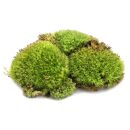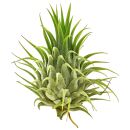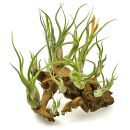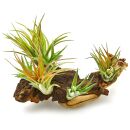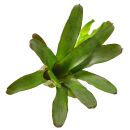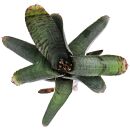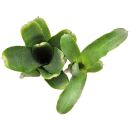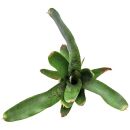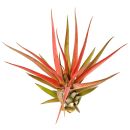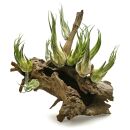- Natural terrarium decoration
- Durable moss cushions
- Freshly green when moist, silvery white when dry
- Lichen-like appearance
- Forms silver-grey curtains and "beards"
- Suitable for subtropical humid forest terrariums
- Small Tillandsia from Guatemala
- About 5 - 8 cm high
- Pink-red leaves during bloom
- Also called Philodendron "Mini"
- Small climbing aroid
- Lanceolate leaves
- Rather slow growth
- Suitable for rainforest terrariums
- Natural hybrid from Central America
- Rosette of narrow leaves
- Epiphyte for moderately dry tropical terrariums
- Small air plant
- Green leaf colour
- Upright rosette of leaves
- Changes colour during flower formation
- Suitable for small tropical terrariums
- Small Tillandsia from Central America
- About 5 - 8 cm high
- Contrasting colours during bloom
- Small Grey Tillandsia from Mesoamerica
- About 5 - 8 cm high
- Contrasting colours during bloom
- Epiphyte from Central America
- Snake-like curved leaves
- For desert or steppe terrariums
- Rainforest Tillandsia from Central America
- Uniform rosette formation
- Turns red in good lighting
- Large bromeliad from Venezuela
- Impressive leaf pattern
- Flaming red inflorescence
- Small funnel bromeliad
- Colours intensively in good light
- Forms offshoots quickly
- Small flowers deep in the funnel
- Suitable for small rainforest terrariums
- Very small funnel bromeliad
- Hybrid from ampullacea and lilliputiana
- Thick, ampulla-like leaves
- Many small flowers in the funnel
- Suitable for rainforest terrariums
- Originates from South America
- Bromeliad family
- Epiphytic growth
- Lance-shaped, striped leaves
- Thrives at 18 - 27 °C
- Epiphytic or substrate cultivation
- Up to 50 cm in diameter
- Bright, indirect light
- Moderate watering
- Leaf rosette stores water
- Tropical origin, South America
- Prefers bright, indirect light
- Colorful leaf patterns
- Compact, rosette-forming growth habit
- Stores water in leaf rosette
- Epiphytic lifestyle
- Bright flower colours
- Decorative leaf pattern
- Low maintenance requirements
- Humid climate preferred
- Bromeliad cultivar
- Delicate blossoms with intense colour
- Water-retaining rosette
- Sunny to semi-shady
- Prefers warm temperatures
- Stem-forming Tillandsia from the Peruan Andes
- Grows naturally on rock faces
- Suitable for moderately dry terrariums
- Large grey Tillandsia
- Silvery grey-green and velvety
- Recommendable for dry forest terrariums
- Attractive epiphyte from Brazil
- Inflorescences with peach tones
- Recommendable for dry forest terrariums
- Rosette-shaped Tillandsia
- size of 10 - 20 cm
- Red leaves in good light and during flowering
- Blue-purple flowers
- Suitable for rainforest terrariums
- Delicate variant of Spanish moss
- Forms grey-green curtains and "beards"
- Suitable for rainforest terraria
- Large epiphyte with conspicuous pseudobulb
- Grows to about 18 - 23 cm in height
- Ideal for drier mountain forest terraria
Terrarium plants - Perennials - Green up your terrarium!
Especially in the tropics and subtropics, many plants grow as epiphytes. Epiphytes grow on trees and shrubs, while plants on rocks are called lithophytes or epiliths. Some of the same species occur as both epiphytes and lithophytes, while others are more specialised. Epiphytes often have special adaptations to hold on and obtain sufficient water and nutrients, such as adhesive roots, water-storing "cisterns" or humus-collecting leaves. Some are in symbiosis with ants. Many epiphytes need a certain layer of loose substrate in which to root and can also be kept as ground or pot plants. However, there are also very "air plants" that only form adhesive roots or are completely rootless. Tillandsias, for example, absorb water and nutrients from precipitation and moist air via suction scales on their leaves, while orchids do this via a special layer of cells on their aerial roots.



